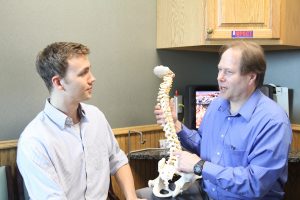
A physiatrist is a medical doctor that works to improve your quality of life by increasing the physical function of your body. This medical specialty is also known as a physical medicine and rehabilitation doctor. If you’re experiencing disability or pain this medical specialty will be very helpful and is the specialist you should see first. Physiatrists take a conservative route to your treatment plan and try medication, holistic treatments, and exercise before deciding that surgery is really necessary.
A physiatrist will lead the treatment for your chronic pain or disability. Not only will the physician administer treatments to help you feel better but they will also coordinate your care with other providers such as physical or occupational therapists, other doctors, councilors and holistic practitioners. Working with a multidisciplinary team helps patients to experience more treatment options and to have better care outcomes.
A physical medicine and rehabilitation doctor is an excellent choice for athletes, soldiers, seniors, anyone experiencing pain, and even people that are trying to recover from a stroke or other brain injury. Your physiatrist can also help to address the problems that occur in the musculoskeletal system that happen because of a sedentary lifestyle.
This kind of doctor has the training to really listen to you, the patient and to help you really look at the different treatment options and decide on the best course of treatment. Your physiatrist will look at your entire body during treatment and not just one organ like many other specialists. The whole body approach leads to better treatment outcomes. Patients that do need surgery can still benefit from seeing a physiatrist; the doctor can speed up your recovery and help you maintain better functionality.
Your physiatrist will give you a treatment plan that focuses on your specific needs and goals. For example if you need to climb stairs or be able to bend down, the treatment goals can focus on helping you achieve the functionality you’re looking to attain.
In addition to traditional means of diagnosis such as physical examination and looking at imaging results physiatrists have a highly specialized diagnostic technique called Electromyography (EMG). An Electromyography (EMG) study can be done on the patient to help the physician diagnose weakness due to dysfunction of the muscles or nerves. The study involves inserting fine needles and sending electrodes into the muscles. The results of the test can determine what the problem is with the muscles or nerves and if the problem is healing or getting worse. A physical medicine and rehabilitation doctor can also help to treat pain with injections.
Physiatrists treat patients with many different kinds of illnesses or injuries. Here are some examples of the most common conditions that patients have:
- Automotive accident injuries
- Work injuries
- Amputees
- Sports injuries
- Stroke recovery
- Brain injury
- Chronic pain
- Back pain
- Neck pain
- Neuromuscular disorders
- Arthritis
- Spinal cord injury
- Herniated disc
- Pinched nerve
- Sciatica
- Fibromyalgia
- Multiple sclerosis
- Cancer rehabilitation
- Parkinson’s disease
Here are just a few of the many circumstances of when you should seek treatment from a physiatrist:
- If you’re experiencing chronic pain.
- If you’re thinking about having surgery to reduce pain.
- If you have nerve damage or had a stroke that is limiting your physical functioning.
- If you would like to speed up the recovery from your surgery.
- If you have and injury that is inhibiting physical functioning and/or causing pain.
